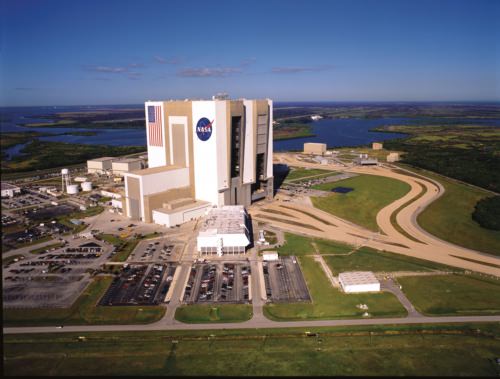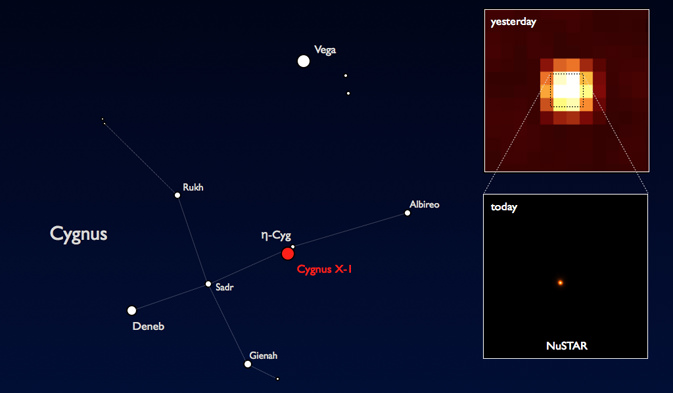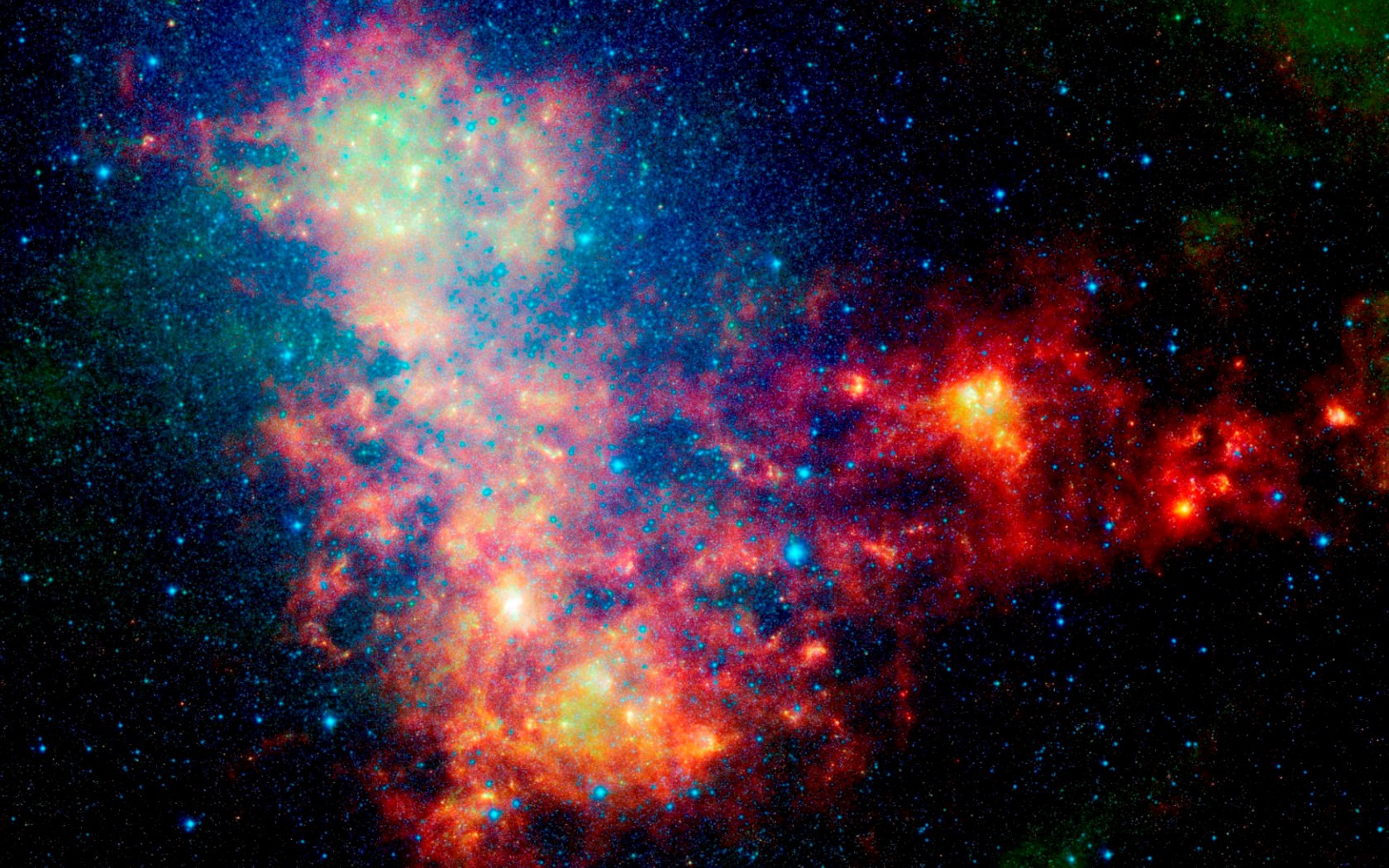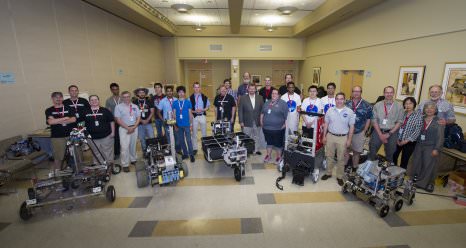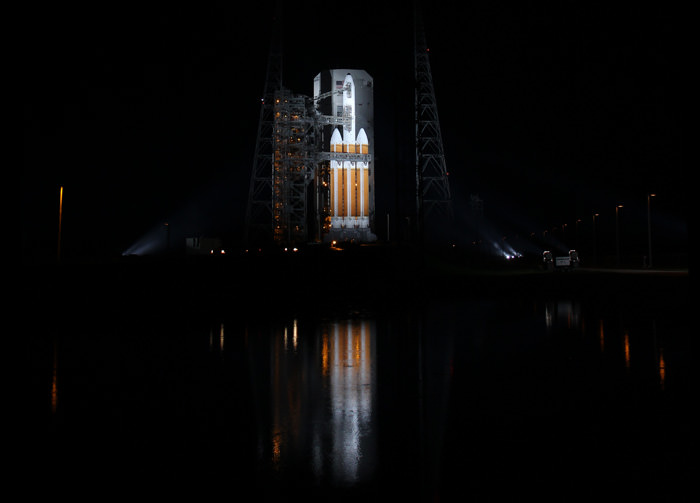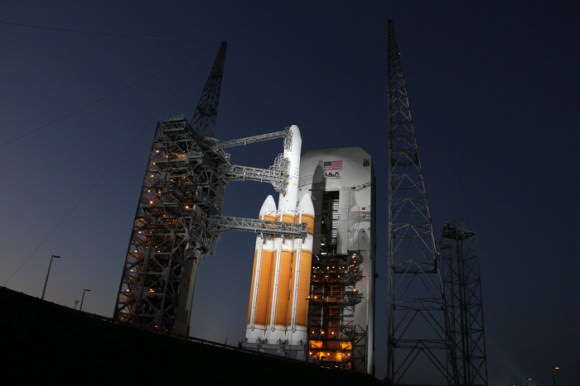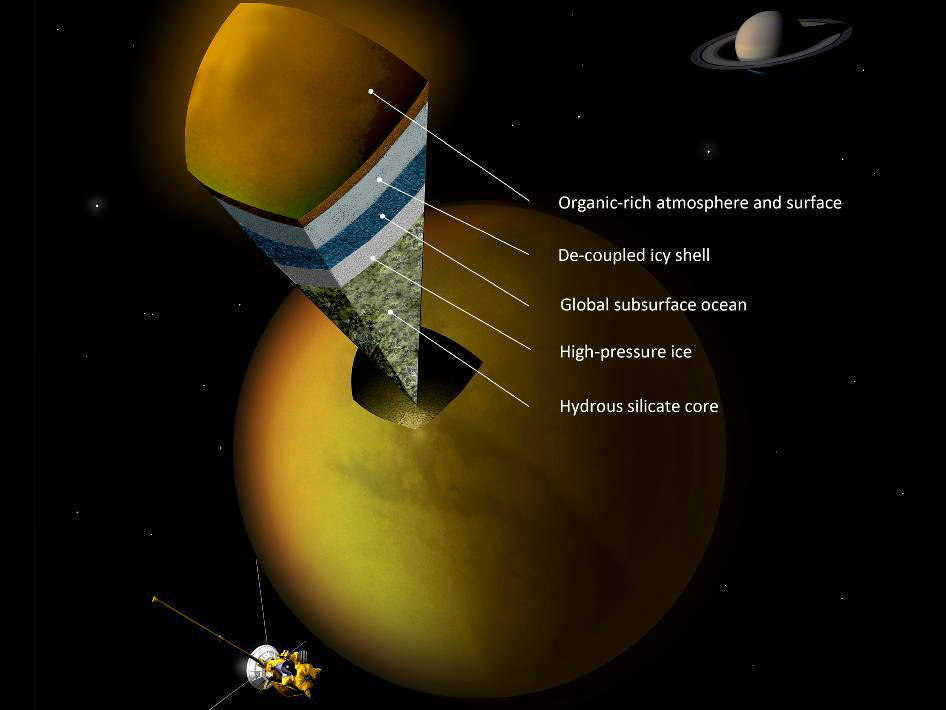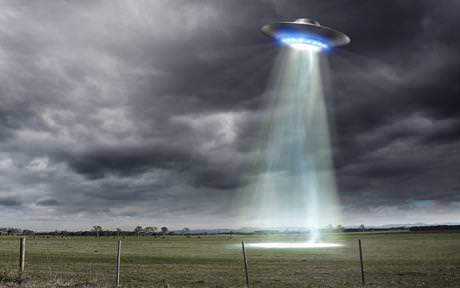On July 1, 1962, the Launch Operations Center in Florida officially became operational. The name was later changed to John F. Kennedy Space Center in honor of the president and his vision of Americans visiting the Moon. This video looks back at the many launches and space exploration highlights that occurred at KSC, so enjoy this look back from where many journeys to space began. If you are going to be near KSC during the US’s 4th of July holiday, NASA is hosting some special events in commemoration of the 50th anniversary. The KSC Visitor Complex is offering rare behind-the-scenes tours for its 50th anniversary year, including one taking visitors inside the massive, 525-foot-tall Vehicle Assembly Building, where the Apollo rockets and space shuttles were assembled.
You can find out more info about the events at the KSC Visitor’s Center website
First Light Image for NuSTAR
Here is the first image taken by the newest space mission, NuSTAR, or the Nuclear Spectroscopic Telescope Array, the first space telescope with the ability to see the highest energy X-rays in our universe and produce crisp images of them.
“Today, we obtained the first-ever focused images of the high-energy X-ray universe,” said Fiona Harrison, the mission’s principal investigator. “It’s like putting on a new pair of glasses and seeing aspects of the world around us clearly for the first time.”
With the successful “first light” images, the mission will begin its exploration of the most elusive and energetic black holes — as well as other areas of extreme physics in our cosmos — to help in our understanding of the structure of the universe.
The first images show Cygnus X-1, a black hole in our galaxy that is siphoning gas off a giant-star companion. This particular black hole was chosen as a first target because it is extremely bright in X-rays, allowing the NuSTAR team to easily see where the telescope’s focused X-rays are falling on the detectors.
NuSTAR launched on June 13 and its lengthy mast, which provides the telescope mirrors and detectors with the distance needed to focus X-rays, was deployed on June 21. The NuSTAR team spent the next week verifying the pointing and motion capabilities of the satellite, and fine-tuning the alignment of the mast.
The mission’s primary observing program is expected to start in about two weeks. But before it does, the team will continue tests and point the NuSTAR at two other bright calibration targets: G21.5-0.9, the remnant of a supernova explosion that occurred several thousand years ago in our own Milky Way galaxy; and 3C273, an actively feeding black hole, or quasar, located 2 billion light-years away at the center of another galaxy. These targets will be used to make a small adjustment to place the X-ray light at the optimum spot on the detector, and to further calibrate and understand the telescope in preparation for future science observations.
Other targets for the mission include the burnt-out remains of dead stars, such as those that exploded as supernovae; high-speed jets; the temperamental surface of our sun; and the structures where galaxies cluster together like mega-cities.
“This is a really exciting time for the team,” said Daniel Stern, the NuSTAR project scientist. “We can already see the power of NuSTAR to crack open the high-energy X-ray universe and reveal secrets that were impossible to get at before.”
Lead image caption: NASA’s Nuclear Spectroscopic Telescope Array, or NuSTAR, has taken its first snapshots of the highest-energy X-rays in the cosmos (lower right), producing images that are much crisper than previous high-energy telescopes (example in upper right). NuSTAR chose a black hole in the constellation Cygnus (shown in the skymap on the left) as its first target due to its brightness. Image credit: NASA/JPL-Caltech
Galactic Gong – Milky Way Struck and Still Ringing After 100 Million Years
When galaxies collide, stars are thrown from orbits, spiral arms are stretched and twisted, and now scientists say galaxies ring like a bell long after the cosmic crash.
A team of astronomers from the United States and Canada say they have heard echoes of that ringing, possible evidence of a galactic encounter 100 million years ago when a small satellite galaxy or dark matter object passed through the Milky Way Galaxy; close to our position in the galaxy, as if a rock were thrown into a still pond causing the stars to bounce up and down on the waves. Their results were published in the Astrophysical Journal Letters.
“We have found evidence that our Milky Way had an encounter with a small galaxy or massive dark matter structure perhaps as recently as 100 million years ago,” said Larry Widrow, professor at Queen’s University in Canada. “We clearly observe unexpected differences in the Milky Way’s stellar distribution above and below the Galaxy’s midplane that have the appearance of a vertical wave — something that nobody has seen before.”
Astronomers took observations from about 300,000 nearby stars in the Sloan Digital Sky Survey. Stars move up and down at 20-30 kilometers per second while see-sawing around the galaxy at 220 kilometers per second. By comparison, the International Space Station putters around Earth at 7.71 kilometers per second; Voyager 1, the fastest man-made object, currently is leaving the solar system at about 17.46 kilometers per second. Widrow and colleagues at the University of Kentucky, The University of Chicago and Fermi National Accelerator Laboratory found that the positions of nearby stars is not quite as regular as previously thought. The team noticed a small but statistically significant difference in the distribution of stars above and below the midplane of the Milky Way.
“Our part of the Milky Way is ringing like a bell,” said Brian Yanny, of the Department of Energy’s Fermilab. “But we have not been able to identify the celestial object that passed through the Milky Way. It could have been one of the small satellite galaxies that move around the center of our galaxy, or an invisible structure such as a dark matter halo.”
Susan Gardner, professor of physics at the University of Kentucky added, “The perturbation need not have been a single isolated event in the past, and it may even be ongoing. Additional observations may well clarify its origin.”
Other possibilities considered for the variations were the effect of interstellar dust or simply the way the stars were selected in the survey. But as those events failed to explain fully the observations, the astronomers began to explore possible recent events in the history of the galaxy.
More than 20 visible satellite galaxies circle the Milky Way. Invisible satellites made up of dark matter, hypothetical matter that cannot be seen but is thought to make up a majority of the mass of the Universe, might also orbit our galaxy. Scientists believe that most of the mass orbiting the galaxy is in the form of dark matter. Using computer simulations to explore the effects of a small galaxy or dark matter structure passing through the disk of the Milky Way, the scientists developed a clearer picture of the see-saw effects they were seeing.
In terms of the nine-billion lifetime of the Milky Way Galaxy, the effects are short-lived. This part of the galaxy has been “ringing” for 100 million years and will continue for 100 million years more as the up-and-down motion dissipates, say the astronomers – unless we are hit again.
Image caption: The Small Magellanic Cloud is one of 20 visible satellite galaxies that orbit the Milky Way Galaxy. Astronomers report that a smaller counterpart or dark matter object passed through the Milky Way near our position about 100 million years ago.
Meteorite Crashes Into London Cab
Londoners awoke this morning to news of a meteorite which struck a taxi in the heart of the city’s busy shopping district Covent Garden. Witnesses were left stunned by what looked like a scene straight out of a science fiction film. An incident team arrived almost immediately to cordon off the meteorite and keep the public at a safe distance.
No one was injured as a result of the incident, but it’s a cosmic harbinger of things to come…
Of course, the “things to come” turn out to be 4 weeks of science programs on Eden TV’s Science Month, which starts up in July.
The incident was in fact a well-orchestrated publicity stunt by the UK’s Eden TV (Sky 532 Virgin 208). Science Month will run all day every day during the month of July. Highlights in the first week include Wonders of the Universe (Monday 2 July at 9pm), Finding Life Beyond Earth (Monday 2 July at 10pm), The Code (Wednesday 4 July at 10pm) and Deadliest Volcano (Thursday 5 July at 7pm).
Sure, after all’s said and done it was a PR stunt. But it was a cool PR stunt (even if not quite scientifically accurate!)
Come on, we all know that meteorites aren’t steaming hot when they land. 😉
Robots Tested in Sample Return Challenge
Caption: Participants in NASA’s Sample Return Robot Challenge. Credit: NASA
Editor’s note: This guest post was written by Andy Tomaswick, an electrical engineer who follows space science and technology.
Picking up rocks can be harder than you’d think. That is one of the lessons to take away from the recently completed Sample Return Robot Challenge hosted by NASA and the Worchester Polytechnic Institute (WPI).
The challenge offered a $1.5 million prize to the robot that could complete a series of automated search and retrieve missions while also meeting NASA’s technical standards for the design of the robot. NASA intended to farm the technologies developed for the competition for design ideas for a possible future Mars sample return mission.
Many NASA employees got to see the technologies first hand at the competition in Massachusetts on a weekend in June. Lori Garver, NASA’s deputy administrator, spoke at a pre-event ceremony followed by a chance for the teams to show off their robots to local high school students, with some 7,000 people in total attending the event.
The actual challenge started off with a test to see if the teams complied with the design regulations handed out by NASA. Five of the six teams that showed up for he event failed to meet the standards, with Team SpacePRIDE from Graniteville, South Carolina the only team to successfully do so. The main difficulty for most teams dealt with a safety-related pause switch which required all moving parts to immediately suspend its movement upon triggering that switch. This would, in theory, save any innocent bystanders from the wrath of an autonomous robot that is not yet subject to the Three Laws of Robotics. Despite the switch not functioning as intended on most robots, all the teams were allowed to participate in the actual event, and the competition went on as planned.
However, the task proved too much for any robot, as none were able to successfully collect the samples needed to meet the challenge’s requirements in the time allotted. The teams did display one of the strengths of the open challenge type format: they all brought very unique ideas to bear on solving the automated problem. Team SpacePRIDE drew particular attention by having a three-robot system, with two smaller scout rovers and one larger collector rover. All of the teams had plenty of feedback to give to the NASA sponsors, and all of the competitors seemed to enjoy themselves as well.
That feedback lies at the real heart of the Centennial Challenge competitions that NASA has been hosting. Even if no one wins the prizes on offer, the challenges themselves draw interest from students around the country as well as spawn ideas from the teams. The good thing about no one completing the challenge this year is that next year the $1.5 million pot is still up for grabs, assuming NASA agrees to sponsor the event again.
Source: NASA Sample Return Robot Challenge Concludes, Team SpacePRIDE
Mighty Delta 4 Heavy Rocket and Clandestine Satellite Poised at Pad
Image caption: The Delta 4 Heavy rocket and Super secret payload stand poised for launch at 6:13 a.m. EDT on June 29, 2012 following retraction of the mobile service tower. Credit: Ken Kremer
A mighty triple-barreled Delta 4 Heavy rocket with a clandestine military satellite perhaps the size of Hubble was unveiled this evening (June 28) at a seaside launch pad at Cape Canaveral, Florida.
The 232 foot tall rocket is poised to blast off at 6:13 a.m. EDT from Space Launch Complex 40 at Cape Canaveral Air Force Station. The exact launch window, like everything else about the classified mission and the NROL-15 spy satellite is top secret.
The mobile service tower was retracted from around the absolutely gorgeous white and orange colored rocket starting around 8:30 p.m. and the super secret spy satellite being launched for the National Reconnaissance Office (NRO) – see my photos.
The launch was delayed a day by the lingering devastation caused by Tropical Storm Debby.
Image caption: Delta 4 Heavy rocket and top secret NRO payload are poised for launch on June 29. Credit: Ken Kremer/www.kenkremer.com
The United Launch Alliance Delta 4 Heavy is flying for the first time with upgraded RS-68A first stage engines, each of which delivers 720,000 pounds of thrust.
This will be the 6th launch of the Delta 4 Heavy – now the most powerful rocket in the US fleet following the shutdown of NASA’s Space Shuttle Program.
As of 12:45 a.m. June 29 , the countdown is now underway ! Fueling will commence shortly. Stay tuned for a post – launch report
China’s Shenzhou-9 and Crew Return to Earth
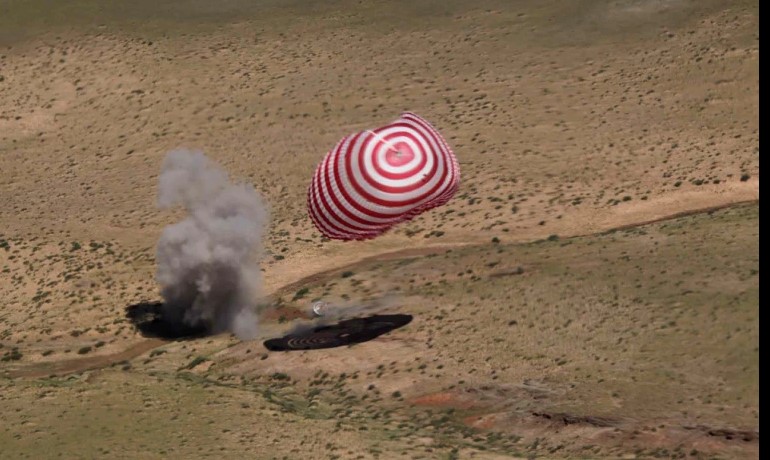
China’s Shenzhou-9 spacecraft and its three-member crew has returned to Earth with a jarring, rolling ground landing in Inner Mongolia at 10:05 local time (02:05 GMT). While in space, the crew successfully carried out their 13-day mission, accomplishing a manual docking with the Tiangong-1 laboratory module and performing a series of experiments. The crew included the first Chinese woman in space, 33-year-old female fighter pilot Liu Yang, along with commander Jing Haipeng, and Liu Wang.
Continue reading “China’s Shenzhou-9 and Crew Return to Earth”
Titan’s Tides Suggest a Subsurface Sea
Saturn’s hazy Titan is now on the short list of moons that likely harbor a subsurface ocean of water, based on new findings from NASA’s Cassini spacecraft.
As Titan travels around Saturn during its 16-day elliptical orbits, it gets rhythmically squeezed by the gravitational pull of the giant planet — an effect known as tidal flexing (see video below.) If the moon were mostly composed of rock, the flexing would be in the neighborhood of around 3 feet (1 meter.) But based on measurements taken by the Cassini spacecraft, which has been orbiting Saturn since 2004, Titan exhibits much more intense flexing — ten times more, in fact, as much as 30 feet (10 meters) — indicating that it’s not entirely solid at all.
Instead, Cassini scientists estimate that there’s a moon-wide ocean of liquid water beneath the frozen crust of Titan, possibly sandwiched between layers of ice or rock.
“Short of being able to drill on Titan’s surface, the gravity measurements provide the best data we have of Titan’s internal structure.”
– Sami Asmar, Cassini team member at JPL
“Cassini’s detection of large tides on Titan leads to the almost inescapable conclusion that there is a hidden ocean at depth,” said Luciano Iess, the paper’s lead author and a Cassini team member at the Sapienza University of Rome, Italy. “The search for water is an important goal in solar system exploration, and now we’ve spotted another place where it is abundant.”
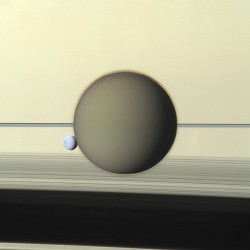 Although liquid water is a necessity for the development of life, the presence of it alone does not guarantee that alien organisms are swimming around in a Titanic underground ocean. It’s thought that water must be in contact with rock in order to create the necessary building blocks of life, and as yet it’s not known what situations may exist around Titan’s inner sea. But the presence of such an ocean — possibly containing trace amounts of ammonia — would help explain how methane gets replenished into the moon’s thick atmosphere.
Although liquid water is a necessity for the development of life, the presence of it alone does not guarantee that alien organisms are swimming around in a Titanic underground ocean. It’s thought that water must be in contact with rock in order to create the necessary building blocks of life, and as yet it’s not known what situations may exist around Titan’s inner sea. But the presence of such an ocean — possibly containing trace amounts of ammonia — would help explain how methane gets replenished into the moon’s thick atmosphere.
“The presence of a liquid water layer in Titan is important because we want to understand how methane is stored in Titan’s interior and how it may outgas to the surface,” said Jonathan Lunine, a Cassini team member at Cornell University, Ithaca, N.Y. “This is important because everything that is unique about Titan derives from the presence of abundant methane, yet the methane in the atmosphere is unstable and will be destroyed on geologically short timescales.”
The team’s paper appears in today’s edition of the journal Science. Read more on the Cassini mission site here.
Top image: artist’s concept showing a possible scenario for the internal structure of Titan. (A. Tavani). Side image: An RGB-composite color image of Titan and Dione in front of Saturn’s face and rings, made from Cassini images acquired on May 21, 2011. (NASA/JPL/SSI. Composite by J. Major.)
Poll: Obama Better Than Romney at Defending Earth from Alien Attack
Not quite sure this is really relevant or at all scientific, but nearly two in three Americans think President Barack Obama would be better than Republican rival Mitt Romney in dealing with an alien invasion, according to a poll done by the National Geographic Channel. Surely, this is in response to the claim that Obama was teleported to Mars as a youth to meet and greet the Martians living there.
In addition, disappointingly, 36% of Americans believe UFOs exist, and 11% claim they have actually seen one, and 20% said they know someone who has seen one, the poll also determined.
In May, the NGC contacted 1,114 adults across the United States to conduct an opinion poll for its new documentary series “Chasing UFOs.” The show premiers Friday with Texas and Colorado residents describing their encounters with mysterious flying objects. Hopefully there will be some science and reality behind this new series. The Houston Chronicle says the new series is a lot like the show “Finding Bigfoot,” and is by the same producers.
Groan.
Lead image caption: Artist concept of a UFO. Photo: Getty Images, via The Telegraph.
Source: Yahoo News
ERGO – Students Sign up to Build the World’s Largest Telescope!
Inspired by SETI Chief, Jill Tarter’s 2009 TED ‘Prize Wish’ to “Empower Earthlings everywhere to become active participants in the ultimate search for cosmic company” the Energetic Ray Global Observatory or ERGO is an exciting new to project that aims to enlist students around the world to turn our whole planet into one massive cosmic-ray telescope to detect the energetic charged particles that arrive at Earth from space. Find out how it works and how your school can get involved Continue reading “ERGO – Students Sign up to Build the World’s Largest Telescope!”

